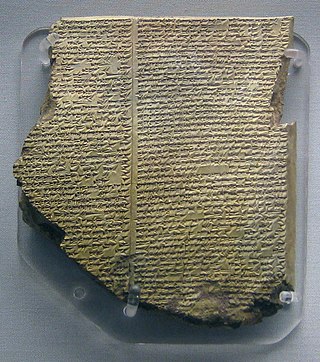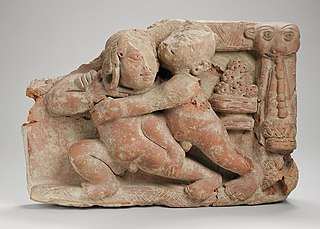Related Research Articles

An epic poem, or simply an epic, is a lengthy narrative poem typically about the extraordinary deeds of extraordinary characters who, in dealings with gods or other superhuman forces, gave shape to the mortal universe for their descendants.

Gilgamesh was a hero in ancient Mesopotamian mythology and the protagonist of the Epic of Gilgamesh, an epic poem written in Akkadian during the late 2nd millennium BC. He was possibly a historical king of the Sumerian city-state of Uruk, who was posthumously deified. His rule probably would have taken place sometime in the beginning of the Early Dynastic Period, c. 2900 – 2350 BC, though he became a major figure in Sumerian legend during the Third Dynasty of Ur.

The Epic of Gilgamesh is an epic poem from ancient Mesopotamia. The literary history of Gilgamesh begins with five Sumerian poems about Bilgamesh, king of Uruk, dating from the Third Dynasty of Ur. These independent stories were later used as source material for a combined epic in Akkadian. The first surviving version of this combined epic, known as the "Old Babylonian" version, dates back to the 18th century BC and is titled after its incipit, Shūtur eli sharrī. Only a few tablets of it have survived. The later Standard Babylonian version compiled by Sîn-lēqi-unninni dates from the 13th to the 10th centuries BC and bears the incipit Sha naqba īmuru. Approximately two-thirds of this longer, twelve-tablet version have been recovered. Some of the best copies were discovered in the library ruins of the 7th-century BC Assyrian king Ashurbanipal.

Corineus, in medieval British legend, was a prodigious warrior, a fighter of giants, and the eponymous founder of Cornwall.

"Jack the Giant Killer" is a Cornish fairy tale and legend about a young adult who slays a number of bad giants during King Arthur's reign. The tale is characterised by violence, gore and blood-letting. Giants are prominent in Cornish folklore, Breton mythology and Welsh Bardic lore. Some parallels to elements and incidents in Norse mythology have been detected in the tale, and the trappings of Jack's last adventure with the Giant Galigantus suggest parallels with French and Breton fairy tales such as Bluebeard. Jack's belt is similar to the belt in "The Valiant Little Tailor", and his magical sword, shoes, cap, and cloak are similar to those owned by Tom Thumb or those found in Welsh and Norse mythology.

Wrestling is a martial art and combat sport that involves grappling with an opponent and striving to obtain a position of advantage through different throws or techniques, within a given ruleset. Wrestling involves different grappling-type techniques such as clinch fighting, throws and takedowns, joint locks, pins, and other grappling holds. Many different wrestling techniques have been incorporated into martial arts, combat sports, and military systems. Wrestling is genuine competition; professional wrestling is athletic theatre.
Oneiromancy is a form of divination based upon dreams, and also uses dreams to predict the future. Oneirogen plants may also be used to produce or enhance dream-like states of consciousness. Occasionally, the dreamer feels as if they are transported to another time or place, and this is offered as evidence they are in fact providing divine information upon their return.

Greco-Roman, Graeco-Roman, classic wrestling is a style of wrestling that is practiced worldwide. Greco-Roman wrestling was included in the first modern Olympic Games in 1896 and has been in every edition of the summer Olympics held since 1904. This style of wrestling forbids holds below the waist, which is the main feature that differentiates it from freestyle wrestling. This restriction results in an emphasis on throws, because a wrestler cannot use trips to bring an opponent to the ground or hook/grab the opponent's leg to avoid being thrown.

Enkidu (Sumerian: 𒂗𒆠𒄭EN.KI.DU10) was a legendary figure in ancient Mesopotamian mythology, wartime comrade and friend of Gilgamesh, king of Uruk. Their exploits were composed in Sumerian poems and in the Akkadian Epic of Gilgamesh, written during the 2nd millennium BC. He is the oldest literary representation of the wild man, a recurrent motif in artistic representations in Mesopotamia and in Ancient Near East literature. The apparition of Enkidu as a primitive man seems to be a potential parallel of the Old Babylonian version (1300–1000 BC), in which he was depicted as a servant-warrior in the Sumerian poems.

Jacob wrestling with the angel is described in the Book of Genesis. The "angel" in question is referred to as "man" and "God" in Genesis, while Hosea references an "angel". The account includes the renaming of Jacob as Israel.
Indian martial arts refers to the fighting systems of the Indian subcontinent. A variety of terms are used for the English phrases "Indian martial arts", deriving from ancient sources. While they may seem to imply specific disciplines, by Classical times they were used generically for all fighting systems.

Malla-yuddha is the traditional form of combat-wrestling originating in the Indian subcontinent. It is closely related to Southeast Asian wrestling styles such as naban and is one of the two ancestors of kushti. Indian wrestling is described in the 13th century Malla Purana.

The Epic of Gilgamesh has directly inspired many manifestations of literature, art, music, and popular culture, as identified by Theodore Ziolkowski in the book Gilgamesh Among Us: Modern Encounters With the Ancient Epic (2011). It was only during and after the First World War that the first reliable translations of the epic appeared that reached a wide audience, and it was only after the Second World War that the epic of Gilgamesh began to make itself felt more broadly in a variety of genres. In the years following World War II, Gilgamesh, formerly an obscure figure known only by a few scholars, gradually became increasingly popular with modern audiences. The Epic of Gilgamesh's existential themes made it particularly appealing to German authors in the years following the war. In his 1947 existentialist novel Die Stadt hinter dem Strom, the German novelist Hermann Kasack adapted elements of the epic into a metaphor for the aftermath of the destruction of World War II in Germany, portraying the bombed-out city of Hamburg as resembling the frightening Underworld seen by Enkidu in his dream. In Hans Henny Jahnn's magnum opusRiver Without Shores (1949–1950), the middle section of the trilogy centers around a composer whose twenty-year-long homoerotic relationship with a friend mirrors that of Gilgamesh with Enkidu and whose masterpiece turns out to be a symphony about Gilgamesh.

The Gilgamesh flood myth is a flood myth in the Epic of Gilgamesh. It is one of three Mesopotamian Flood Myths: the Sumerian Flood Story, an episode of the Atra-Hasis Epic and included in the Epic of Gilgamesh. Many scholars believe that the flood myth was added to Tablet XI in the "standard version" of the Gilgamesh Epic by an editor who used the flood story from the Epic of Atra-Hasis. A short reference to the flood myth is also present in the much older Sumerian Gilgamesh poems, from which the later Babylonian versions drew much of their inspiration and subject matter.

Although the earliest evidence of martial arts goes back millennia, the true roots are difficult to reconstruct. Inherent patterns of human aggression which inspire practice of mock combat and optimization of serious close combat as cultural universals are doubtlessly inherited from the pre-human stage and were made into an "art" from the earliest emergence of that concept. Indeed, many universals of martial art are fixed by the specifics of human physiology and not dependent on a specific tradition or era.
Papyrus Oxyrhynchus III 466 is a fragmentary 2nd century Greek papyrus manuscript containing instructions for wrestling, including the description of various grips and holds, constituting the earliest historical European martial arts manual along with P.Oxy LXXIX 5204. The papyrus was given to Columbia University by the Egypt Exploration Society in 1907.

Wrestling and grappling sports have a long and complicated history, stretching into prehistoric times. Many traditional forms survive, grouped under the term folk wrestling. More formal systems have been codified in various forms of martial arts worldwide, where grappling techniques form a significant subset of unarmed fighting.

Cormoran is a giant associated with St. Michael's Mount in the folklore of Cornwall. Local tradition credits him with creating the island, in some versions with the aid of his wife Cormelian, and using it as a base to raid cattle from the mainland communities. Cormoran appears in the English fairy tale "Jack the Giant Killer" as the first giant slain by the hero, Jack, and in tales of "Tom the Tinkeard" as a giant too old to present a serious threat.
Epic is a narrative genre characterised by its length, scope, and subject matter. The defining characteristics of the genre are mostly derived from its roots in ancient epics. The epic is no longer limited to the traditional medium of oral poetry, but has expanded to include modern mediums including film, theater, television shows, novels, and video games.

Jacket wrestling is a form of wrestling and one of the oldest form of sports that has been practiced in both Europe and Asia going back many centuries. It generally involves two contestants wearing jackets and belts attempting to take each other down in an attempt to pin their opponent. The method of combat has also been referred to as "belt-and-jacket wrestling", for its common use of a belt or sash in addition to or instead of a jacket.
References
- ↑ "Wrestling, Freestyle" by Michael B. Poliakoff, in Encyclopedia of World Sport: From Ancient Times to the Present, Vol. 3, pp. 1189, 1193, eds. David Levinson and Karen Christensen (Santa Barbara, CA: ABC-CLIO, Inc., 1996).
- 1 2 Gyldendals store konversasjonsleksikon|Gyldendals store konversasjons-leksikon, 1972 (third edition), p.2563–4. ISBN 978-82-05-00267-8.
- ↑ Poliakoff, Clare; Poliakoff, Michael B. (Summer 1984), "Jacob, Job, and Other Wrestlers: Reception of Greek Athletics by Jews and Christians in Antiquity" (PDF), Journal of Sport History, 11 (2): 48–65, ISSN 0094-1700
- ↑ Vyasa, Krishna-Dwaipayana; Ganguli, Kisari Mohan (1883–1896), "Section XXIII", The Mahabharata, p. 51, retrieved 2007-10-08